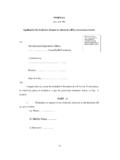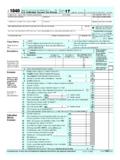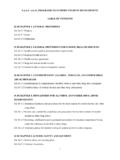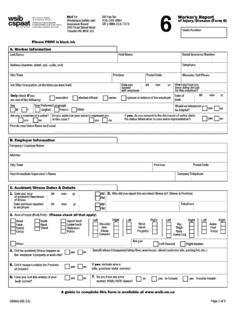Transcription of Name that Cloud - VDOE
1 Science Enhanced Scope and Sequence Grade 4 virginia department of education 2012 1 name that Cloud Strand Interrelationships in Earth/Space Systems Topic Investigating the weather Primary SOL The student will investigate and understand how weather conditions and phenomena occur and can be predicted. Key concepts include a) weather phenomena. Related SOL The student will demonstrate an understanding of scientific reasoning, logic, and the nature of science by planning and conducting investigations in which l) models are constructed to clarify explanations, demonstrate relationships, and solve needs; m) current applications are used to reinforce science concepts.
2 Background Information Clouds consist of water droplets and ice crystals and are formed around small particles of dust. Cirrus clouds are wispy clouds made of ice crystals, usually at very high altitudes, and indicate that a change in weather is coming. Stratus clouds are large, flat, layered clouds, often at a low altitude and are associated with rainy weather. Cumulus clouds are lumpy, puffy clouds, are often seen on sunny days, and are associated with fair weather. Cumulonimbus clouds, or thunderstorm clouds, are giant cumulus clouds that reach from near the surface of the earth to the upper atmosphere.
3 Materials Science journals or loose leaf paper Pictures of Cloud types from the Internet or magazines Cotton balls Glue Blue construction paper Black marker 2 liter plastic bottle with tight fitting lid Matches Water Vocabulary cirrus clouds, stratus clouds, cumulus clouds, cumulonimbus clouds Student/Teacher Actions (what students and teachers should be doing to facilitate learning) Introduction 1. Ask students what clouds look like. Once students have given many answers, explain that clouds look different based on the different types. Let students know that you are going to form one type of Cloud in the classroom.
4 Science Enhanced Scope and Sequence Grade 4 virginia department of education 2012 2 2. To demonstrate the forming of clouds, do the following: a. Gather your needed materials: a 2 liter clear plastic bottle with a screw on cap, matches, and warm water. b. Fill the 2 liter bottle one third full of warm water and screw the cap on. (Water is the first ingredient needed to make a Cloud .) Ask the students why you would need water and why you are using warm water. Make sure they can relate that Cloud formation starts with evaporation, from water areas or moist ground areas.
5 C. Shake the bottle so that water droplets are sticking to the inside of the bottle. Then pour out the excess water and immediately screw the cap back on. d. Using both hands, squeeze the center of the bottle as hard as you can. Then release both hands evenly and very quickly. (The second ingredient in clouds is a change in air pressure and temperature.) Ask the students why they didn t see anything happen when you changed the air pressure in the bottle? (If the inside of the bottle becomes covered with condensation, just shake the bottle to get rid of it.) Ask the students why they can t see a Cloud since we have water and a change in air pressure caused by squeezing the bottle.
6 E. Tell the students that we are going to add the third needed ingredient for a Cloud . (Dust, smoke or other particles in the air are the third ingredient we need so that the water molecules have a surface on which to collect.) f. Tell the students that you are going to light a match, drop it in the bottle, close the bottle, and shake it to make the match go out. Ask them what dropping a lit match and extinguishing it right away will do to help us build a Cloud . (Before you do the next step, emphasize with your students that they should never do this experiment by themselves.)
7 They always need an adult with them.) g. Remove the top of the plastic bottle. Carefully light a match, drop it in the bottle, quickly put the top back on, and shake the bottle so the match burns out. Ask the students what you have added to your Cloud ingredients? h. Again squeeze the center of the bottle using both hands. You should see a Cloud appear when you quickly release your hands. (If it is difficult for students to see the Cloud , put the bottle near a dark background. Ask the students what the three main ingredients are to make a Cloud . i. Explain to students that clouds form when warm, moist air rises, cools, and expands or when air masses collide with one another.
8 The water vapor condenses upon dust particles to form a Cloud in the atmosphere. Procedure 1. Ask the students if every Cloud they see in the sky looks the same? 2. Explain that clouds are classified by shape and altitude. Show students pictures of different types of clouds, one at a time. Have them draw the clouds and define them in their science journals. Science Enhanced Scope and Sequence Grade 4 virginia department of education 2012 3 Cirrus high, wispy or feathery clouds composed of ice crystals. Altitude: 7,000 13,000 m. Stratus (meaning sheet or layer ) low, flat, layered, and gray clouds.
9 Altitude: 500 2,000 m. Cumulus (meaning heap ) thick, white, and fluffy clouds with flat bases. Altitude: 500 1,800 m. Cumulonimbus (meaning rain bearing heap ) large, dark gray clouds with flat bottoms. Altitude: 500 18,000 m. 3. Have students make a chart of the four types of clouds, using cotton balls and blue construction paper. Instruct students to glue the cotton clouds on the paper to approximate where the Cloud type would appear in the sky. Have them use a black marker to include Cloud names and a brief description of each. Conclusion 1. Discuss the type of weather associated with each Cloud type: Cirrus clouds often indicate the location of a distant storm or approaching change in the weather.
10 Stratus clouds are associated with moist weather light, steady rain, snow, or small ice particles, with fog at ground level. Cumulus clouds are often present during fair weather. Cumulonimbus thunderheads are associated with thunderstorms, lightning, heavy rain, hail, and tornadoes. 2. Have students share their Cloud pictures with a neighboring classroom or lower level class to demonstrate their understanding of each type, what helped form it, and the weather associated with it. Assessment Questions o What are the main ingredients needed to make a Cloud ? o What is the difference between a cirrus and a stratus Cloud ?














